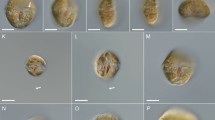Abstract
A new dinoflagellate Durinskia capensis Pienaar, Sakai et Horiguchi sp. nov. (Peridiniales, Dinophyceae), from tidal pools along the west coast of the Cape Peninsula, Republic of South Africa, is described. The dinoflagellate produces characteristic dense orange–red colored blooms in tidal pools. The organism is characterized by having a eukaryotic endosymbiotic alga. Ultrastructure study revealed the organism has a cellular construction similar to that of other diatom-harboring dinoflagellates. The cell is thecate and the plate formula is: Po, x, 4′, 2a, 6″, 5c, 4s, 5″′, 2″″, which is the same as that of Durinskia baltica, the type species of the genus Durinskia. D. capensis can, however, be distinguished from D. baltica by overall cell shape, the relative size of the 1a and 2a plates, the degree of cingular displacement, and the shape of the eyespot. Our molecular analysis based on SSU rDNA revealed that D. capensis is closely allied to D. baltica, thus supporting the assignment of this new species to this genus. This Durinskia clade takes a sister position to another diatom-harboring dinoflagellate clade, which includes Kryptoperidinium foliaceum and Galeidinium rugatum. Molecular analysis based on the rbcL gene sequence and ultrastructure study revealed that the endosymbiont of D. capensis is a diatom. The SSU rDNA gene trees indicated that four species with a diatom endosymbiont formed a clade, suggesting a single endosymbiotic origin.










Similar content being viewed by others
References
Carty S, Cox ER (1986) Kansodinium gen. nov. and Durinskia gen. nov.: two genera of freshwater dinoflagellates (Pyrrhophyta). Phycologia 25:197–204
Chesnick JM, Cox ER (1985) Thecal plate tabulation and variation in Peridinium balticum (Pyrrhophyta: Peridiniales). Trans Am Microsc Soc 104:387–394
Chesnick JM, Morden CW, Schmieg AM (1996) Identity of the endosymbiont of Peridinium foliaceum (Pyrrophyta): analysis of the rbcLS operon. J Phycol 32:850–857
Chesnick JM, Kooistra WHCF, Wellbrock U, Medlin LK (1997) Ribosomal RNA analysis indicates a benthic pennate diatom ancestry for the endosymbionts of the dinoflagellates Peridinium foliaceum and Peridinium balticum (Pyrrhophyta). J Euk Microbiol 44:314–320
Dodge JD (1983) A re-examination of the relationships between unicellular host and eukaryotic endosymbiont with special reference to Glenodinium foliaceum (Dinophyceae). In: Schenk HEA, Schwemmler W (eds) Endocytobiology II. De Gruyter, Berlin, pp 1015–1026
Felsenstein J (1985) Confidence limits on phylogenies: an approach using the bootstrap. Evolution 39:783–791
Horiguchi T Chihara M (1993) Life cycle and ultrastructure of Dinothrix paradoxa (Dinophyceae). In: 15th International botanical congress abstract, Yokohama, p 216
Horiguchi T, Pienaar RN (1988) A review of dinoflagellates containing endosymbiotic algae, from South Africa. Abstracts from the 3rd international Phycological Congress, Melbourne, Australia 14–20 Aug, 1988, p 19
Horiguchi T, Pienaar RN (1991) Ultrastructure of a marine dinoflagellate, Peridinium quinquecorne Abé (Peridiniales) from South Africa with particular reference to its chrysophyte endosymbiont. Bot Mar 34:123–131
Horiguchi T, Pienaar RN (1994) Ultrastructure of a new marine sand-dwelling dinoflagellate Gymnodinium quadrilobatum sp. nov. (Dinophyceae) with special reference to its endosymbiotic algae. Eur J Phycol 29:237–245
Inagaki Y, Dacks JB, Doolittle WF, Watanabe KI, Ohama T (2000) Evolutionary relationship between dinoflagellates bearing obligate diatom endosymbionts: insight into tertiary endosymbiosis. Int J Syst Evol Microbiol 50:2075–2081
Jeffrey SW, Vesk M (1976) Further evidence for a membrane-bound endosymbiont within the dinoflagellate Peridinium foliaceum. J Phycol 12:450–455
Kempton JW, Wolny J, Tengs T, Rizzo P, Morris R, Tunnell J, Scott P, Steidinger K, Hymel SN, Lewitus AJ (2002) Kryptoperidinium foliaceum blooms in South Carolina: a multi-analytical approach to identification. Harmful Algae 1:383–392
Levander KM (1892) Notiz über die Tafelung der Schalenmembran des Glenodinium cinctum Ehbg. Zoo Anz 15:405–408
Lindemann E (1924) Der Bau der Hülle Bei Heterocapsa und Kryptoperidinium foliaceum (Stein) n. nov. (zugleich eine vorl. Mitteilung). Bot Arch 5:114–120
Pienaar RN (1980) The ultrastructure of Peridinium balticum (Dinophyceae) with particular reference to its endosymbiosis. Proc Electron Microscop Soc S Afr 10:75–76
Posada MA, Crandall KA (1998) Modeltest: testing the model of DNA substitution. Bioinformatics 14:817–818
Reynolds EC (1963) The use of lead citrate at high pH as an electron opaque stain in electron microscopy. J Cell Biol 17:208–212
Schnepf E, Elbrächter M (1999) Dinophyte chloroplasts and phylogeny—a review. Grana 38:81–97
Spurr AR (1969) A low viscosity epoxy resin embedding medium for electron microscopy. J Ultrastruct Res 26:31–43
Swofford DL (2002) PAUP*-Phylogenetic Analysis Using Parsimony (* And Other Methods), Version 4. Sinauer Associates, Sunderland
Takano Y, Horiguchi T (2004) Surface ultrastructure and molecular phylogenetics of four unarmoured heterotrophic dinoflagellates, including the type species of Gyrodinium (Dinophyceae). Phycol Res 52:106–117
Tamura M, Shimada S, Horiguchi T (2005) Galeidinium rugatum gen. et sp. nov. (Dinophyceae), a new coccoid dinoflagellate with a diatom endosymbiont. J Phycol 41:658–671
Tomas R, Cox ER (1973) Observations on the symbiosis of Peridinium balticum and its intracellular alga I: ultrastructure. J Phycol 9:304–323
Tomas RN, Cox ER, Steidinger KA (1973) Peridinium balticum (Levander) Lemermann, an unusual dinoflagellate with a mesocaryotic and an eukaryotic nucleus. J Phycol 9:91–98
Withers NW, Cox ER, Tomas R, Haxo FT (1977) Pigments of the dinoflagellate Peridinium balticum and its photosynthetic endosymbiont. J Phycol 13:354–358
Yamaguchi A, Horiguchi T (2005) A molecular phylogenetic study of the heterotrophic genus, Protoperidinium (Peridiniales, Dinophyceae). Phycol Res 53:38–50
Acknowledgments
The authors wish to thank Dr Stuart D. Sym for checking Latin diagnosis. RNP acknowledges financial assistance from the National Research Foundation. This work was partly supported by the twenty-first century Center of Excellence (COE) Program on “Neo-Science of Natural History” (Program Leader: Hisatake Okada) at Hokkaido University financed by the Ministry of Education, Culture, Sports, Science and Technology (MEXT), Japan. The work was also financed by the Grant-in-Aid (12NP0102, 16370039) from the MEXT.
Author information
Authors and Affiliations
Corresponding author
Rights and permissions
About this article
Cite this article
Pienaar, R.N., Sakai, H. & Horiguchi, T. Description of a new dinoflagellate with a diatom endosymbiont, Durinskia capensis sp. nov. (Peridiniales, Dinophyceae) from South Africa. J Plant Res 120, 247–258 (2007). https://doi.org/10.1007/s10265-006-0047-y
Received:
Accepted:
Published:
Issue Date:
DOI: https://doi.org/10.1007/s10265-006-0047-y



